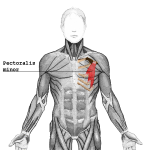Think about the last time you were out of breath. I’ll give you a second. Ok, got that mental picture? Good.
Now what did you see? Did you notice quick, shallow breaths mostly coming from the chest and neck? You probably also pictured your chest lifting up to pull air into your lungs? This type of breathing is what we call chest breathing, or also know as shallow breathing.
Now think about last night as you were getting ready to sleep, lying in a comfortable position in your bed. You most likely pictured deeper breaths with longer inhales and exhales. And you probably noticed your chest staying quiet while your belly filled up with every inhale. This is what we like to call deep breathing or belly breathing. This type of breathing uses the diaphragm muscle, a dome shaped muscle that sits just below the ribcage and is the most efficient breathing muscle we have.
Ok, so why does this matter? Do I really need to know about the way I breathe? Yes you do. I’ll explain below.
Most of us run around in today’s world breathing way too much from our chest and neck. It’s not something you really pay much attention to. I know I certainly didn’t. But once I understood the mechanics of breathing, I started to pay closer attention. I then realized that I was a big-time chest breather.
I’ve also noticed the same with many of my clients. I see extremely tight neck muscles and a pec minor muscle that is extremely overworked from all this chest breathing.
Pec minor, what the hell is that you ask?
Ok, take your left thumb and place it on the front side of where your shoulder and chest connect. Now press deep with that thumb. A little deeper. I bet it’s a little tender. That’s your pec minor.
Ok, so why is this bad? It’s bad because these muscles aren’t designed as major breathing muscles. You can think of them like back-up breathing muscles. But when the back-up breathing muscles have to perform every day, every breath, this can lead to a host of issues. Chronic neck pain, bad posture, shoulder issues, etc.
What then is the solution!?
Learn to use your diaphragm and focus on deep breathing. The diaphragm is very efficient at doing its job of breathing. Also, by using this proper breathing muscle, you will take needed stress off of the emergency breathing muscles of the neck and chest.
Here’s a simple video to see if you’re using your diaphragm to breathe. You can also use this exercise to help train your diaphragm so that’s it’s more functional. With a fully functional diaphragm you will notice improvements right away.
Here are 3 benefits of belly breathing:
1) Helps manage stress
The autonomic nervous system has 2 main systems – the sympathetic which is known as “fight or flight” and parasympathetic, know as “rest and digest.” Most of us run around all day in a heightened fight or flight state (sympathetic system). While effective at allowing us to out-run a tiger or lion, increased time in a sympathetic state can create elevated and damaging stress on the body. Deep breathing triggers the parasympathetic system (rest and digest), allowing the body to recover properly and helps manage stress.
2) Reduces blood pressure
Related to the above parasympathetic state, deep breathing has also been shown to reduce blood pressure. Check out this study here.
3) Better performance
Deep breathing will better equip your body to handle higher intensity exercise. Chest breathing will fatigue and create chronically tight neck and chest muscles creating pain and compensation patterns in the body. This will compromise performance and could lead to higher risk of injury.
Give the ‘ole belly breathing a shot and keep me posted on how it goes. Remember, just like your arm or butt muscle, the diaphragm is a muscle that you either use…or lose.
Happy belling breathing.
Nick






